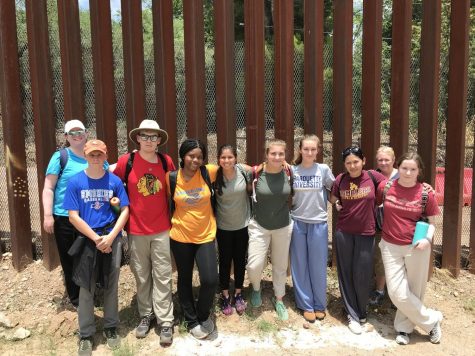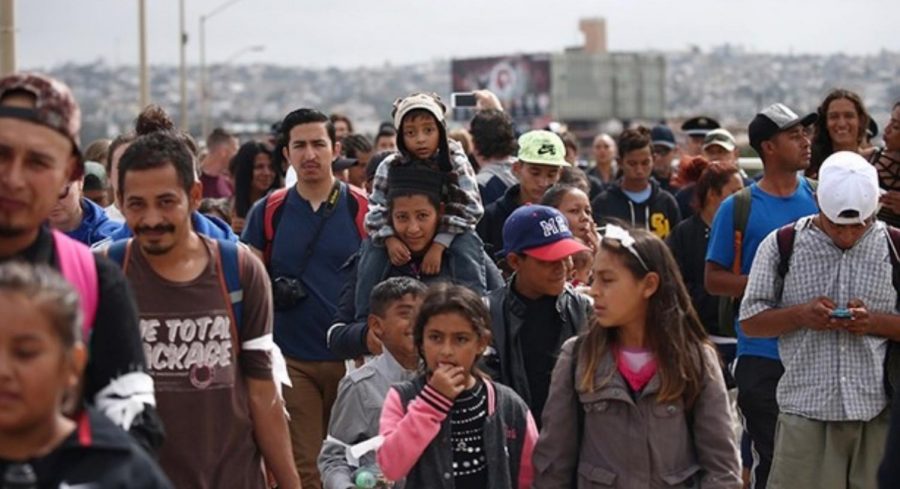Migrant Caravan Advances to US Southern Border
November 13, 2018
An extremely large group of Latino men, women, and children are marching towards the United States-Mexico border. Most members of the caravan say they are fleeing poverty, persecution, and violence in their home countries of Guatemala, El Salvador, and Honduras. Honduras especially has severe problems with gang violence, drugs, and government corruption. The murder rate is also one of the highest in the entire world. The caravan is looking for a better future in Mexico and the United States, by finding jobs and a safer residence. Many immigrants are seeking to apply for asylum or refugee status in the US, due to the gang violence most had suffered in their home country.
The caravan began with 160 people leaving Honduras on October 12. By the end of the next day, the numbers had increased upwards of 1,000 due to heavy social media use. A spokesperson for the United Nations was quoted saying that the caravan had even reached more than 7,000 members as of October 22. This has gained national attention as one of the first large and organized caravans to leave Central America.
Donald Trump, the President of the United States America, has had his attention caught by the caravan. He has criticized the countries for allowing these migrants to “illegally enter” the US. Trump stated that he will send 5,200 US military to protect the southern border from the illegal asylum seekers. However, he also said tent cities will be created to house the group, until a proper solution can be created. Eradicating illegal immigration was the main campaign promise Trump was elected on, and he seems determined to keep it.
Life on the road is especially difficult for the migrants. They must always stay as a pack in order to ward off dangerous attacks from gangs along the way. Human traffickers and drug lords are known to kidnap people, so a caravan is necessary. The constant, burning heat of Southern America is also a large factor, along with dehydration. Most migrants also do not have proper footwear for such a trek, due to their extreme poverty they are attempting to escape. The migrants rely on generous donations of food and shelter from the towns they pass through to survive.
Another danger most face is the threat of disease. The majority of asylum seekers shower using water pipes, combined with the close-quarters, means an epidemic could spread quite easily. These obstructions and difficulties symbolize the trouble migrants are willing to go through for a better life.
As of November 10, the migrants face a very important decision. The caravan has split into two 3,000 migrant groups, with smaller groups of hundreds of migrants following along. The largest and leading caravan has been resting in a soccer stadium Mexico City has set up for them. The group now faces the momentous decision of which route to take.
There are two main options. The fastest route possible would be to travel along Mexico’s Gulf Coast and cross in southern Texas. However, this route is also seen as the most dangerous. Attacks from criminal groups are much more likely on this shorter route. The most likely route is the Tijuana-San Diego route. This route is considered the safest; however, it is about twice as long as the other one. All migrant families must make a choice that will affect their families’ lives forever.
Ultimately, this issue impacts Loyola Academy directly. A group of Loyola students, led by Mr. Baier from the Campus Ministry office, traveled to northern Mexico over the summer. They served people at soup kitchens, and talked to migrants. They also discussed the plight of Mexican citizens who were thinking about making the cross. The students learned the difficulty of living as a migrant, and sympathized with their cause. They also spoke with a federal judge, as well as border patrol officers who explained the difficulty most migrants face. This trip opened the eyes of many people at Loyola, and many empathize with the migrant caravan today.

Loyola students volunteer at the border during their summer service trip.


